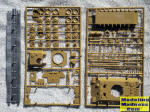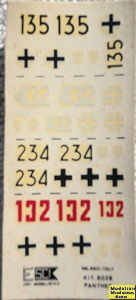
ESCI 1/72 Panther Ausf A
| KIT #: | 8026 |
| PRICE: | $ cheep |
| DECALS: | Four options |
| REVIEWER: | Rick Reinbott |
| NOTES: | 86 parts on 2 sprues |

| HISTORY |
The Panther was a German medium tank deployed during World War II on the Eastern and Western Fronts in Europe from mid-1943 to its end in 1945. It had the ordnance inventory designation of Sd.Kfz. 171. Until 27 February 1944, it was designated as the Panzerkampfwagen V Panther when Hitler ordered that the Roman numeral "V" be deleted. Contemporary English language reports sometimes refer to it as the Mark V. The Panther was intended to counter the Soviet T-34 and to replace the Panzer III and Panzer IV. Nevertheless, it served alongside the latter and the heavier Tiger I until the end of the war. It is considered one of the best tanks of World War II for its excellent firepower and protection. Its reliability was less impressive.
The first 20 vehicles to be built were designated Ausf. A although from early 1942 their official title was Ausf D1 . On subsequent vehicles the armor was increased to 80mm on the glacis and 120mm on the mantlet. This had the effect of increasing the tank's weight from 35 tons to 45 tons, and to compensate for this the more powerful Maybach HL230 P30 engine was installed together with an AK&-200 seven speed synchromesh gearbox. Other improvements included movement of the commander's cupola slightly inboard, the replacement of the single with a double-baffle muzzle brake on the KwK 42 75mm main gun and the addition of short side skirts in May 1943. The completed modif9ication was designated Ausf. D2. The second major production type was designated, for no apparent reason, Ausf. A, and began entering service shortly after the ill-starred Kursk offensive. The principal modiifications included in the is variant were a much improved cupola, a ball mounting for the hull machine gun and an increase in the number of rim bolts on the road wheels. The last production model was the Ausf. G, which appeared in the spring of l 944. On this version construction had been simplified and internal space gained by fixing the upper-hull side plates at a less oblique angle, but the vehicle was more easily recognized by the absence of the driver's vision hatch in the mantlet, this being replaced by a rotating episcope in the roof of the driving compartment. In addition the driver's and operator's swinging pivot access hatches were replaced by a hinged type. Late models were fitted with resilient steel road wheels and a new mantlet which avoided the downwards-deflection dangers of the earlier rounded type by being thickened at the base.
The Panther was a compromise. While having essentially the same engine as the Tiger I, it had more efficient frontal hull armour, better gun penetration, was lighter and faster, and could traverse rough terrain better than the Tiger I. The trade-off was weaker side armour, which made it vulnerable to flanking fire. The Panther proved to be effective in open country and long range engagements, but did not provide enough high explosive firepower against infantry.
Designed by Germany to counter the Soviet T-34 medium tank, the Panzerkampfwagen V Panther was deployed from mid-1943 to the end of the war in Europe in 1945. It is considered one of the best tanks of World War II for its excellent firepower and protection.
The first 20 vehicles to be built were designated Ausf. A, although from early 1942 their official title was Ausf. D1. On subsequent vehicles the armor was increased to 80mm on the glacis and 120mm on the mantlet. This had the effect of increasing the tank's weight from 35 to 45 tons, and to compensate for this the more powerful Maybach HL230 P30 engine was installed together with an AK7-200 seven-speed synchromesh gearbox. Other improvements included movement of the commander's cupola slightly inboard, the replacement of the single with a double-baffle muzzle brake on the KwK 42 75mm main gun and the addition of short side skirts in May 1943. The completed modification was designated Ausf. D2. The second major production type was designated, for no apparent reason, Ausf. A and began entering service shortly after the ill-starred Kursk offensive. The principal modiifications included in the variant were a much improved cupola, a ball mounting for the hull machine gun and an increase in the number of rim bolts on the road wheels. The last production model was the Ausf. G, which appeared in the spring of 1944. On this version construction had been simplified and internal space gained by fixing the upper-hull side plates at a less oblique angle, but the vehicle was more easily recognized by the absence of the driver's vision hatch in the mantlet, this being replaced by a rotating episcope in the roof of the driving compartment. In addition, the driver's and operator's swinging pivot access hatches were replaced by a hinged type. Late models were fitted with resilient steel road wheels and a new mantlet that avoided the downwards-deflection dangers of the earlier rounded type by being thickened at the base.
The Panther was a compromise. While having essentially the same engine as the Tiger I, it had more efficient frontal hull armor and better gun penetration. It was lighter and faster and could traverse rough terrain better than the Tiger I. The trade-off was weaker side armor, which made it vulnerable to flanking fire. The Panther proved to be effective in open country and long-range engagements, although it was found to be lacking in high explosive firepower against infantry.
| THE KIT |
 Upon
opening the box, you’re presented with two sprues. All parts are molded in
medium tan and show very nice detail. A commander figure is included with the
kit. There is very little flash, although there are mold seams around some
parts, which will need to be scraped/ sanded for a smooth finish. There are no
ejector pin marks on the parts. The kit was packaged in a plastic bag rather
than a box, so I couldn’t locate a copyright date, although my research
indicated that this boxing was released circa 1983.
Upon
opening the box, you’re presented with two sprues. All parts are molded in
medium tan and show very nice detail. A commander figure is included with the
kit. There is very little flash, although there are mold seams around some
parts, which will need to be scraped/ sanded for a smooth finish. There are no
ejector pin marks on the parts. The kit was packaged in a plastic bag rather
than a box, so I couldn’t locate a copyright date, although my research
indicated that this boxing was released circa 1983.
The various tools are all
molded separately and are nicely done. The rough cast texture on the turret,
commander cupola, gun mantlet and upper hull is restrained and well represented
for a small-scale kit. The cupola and hull machine guns are molded solid, so
they’ll need to be hollowed out if one wishes. The 75mm main gun is in two
halves. Plastic tow cables are included, although one may wish to just use the
cable ends and scratchbuild cables out of fine wire. The tracks are of the
one-piece vinyl type with fair detail on the outside but none on the inside.
There are also spare track links included to
 be attached
to the turret and rear hull. Hull hatches can be posed opened or closed, but
there is no interior. No clear parts are included.
be attached
to the turret and rear hull. Hull hatches can be posed opened or closed, but
there is no interior. No clear parts are included.
The instructions are of the fold-out type and are well illustrated with exploded views showing a six-step construction sequence. There is a diagram showing all the numbered parts, as well as two photographs of actual Panther tanks. Also included are vehicle specifications and a decal placment guide on a camoflauged tank, yet there is no painting guide for the pattern shown. The decals, in spite of their age, look to be useable and include markings for four vehicles, but I was not able to identify the markings with any known division or unit on the basis of my research.
Although this kit has been around for a while, that certainly doesn’t detract from it being a nice kit that should look great when finished. Recommended!
| REFERENCES |
The PzKpfw V Panther by Bryan Perrett, Osprey Publications (1981).
Wikipedia: https://en.wikipedia.org/wiki/Panther_tank
November 2016
Copyright ModelingMadness.com
If you would like your product reviewed fairly and fairly quickly, please contact the editor or see other details in the Note to Contributors.
Back to the Main Page Back to the Previews Index Page Back to the Review Index Page